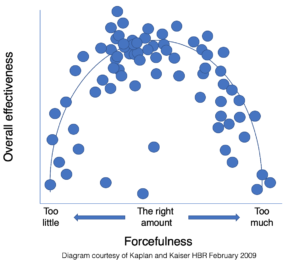28 Feb Strengths overdone become a weakness
While working with an executive coaching client facing a tricky change management situation, I came across Stop Overdoing Your Strengths, a telling HBR article by Bob Kaplan and Rob Kaiser.
Kaplan’s and Kaiser’s messages about the dangers of over-doing your strengths as a leader are enduring, powerful truths. And their practical application helped my client see that the more forceful she became with her team, the less she succeeded in getting the results expected by the executive committee.
We’ve all heard the maxim, ‘To win, play to your strengths’. Our strengths are our default position – the things that come naturally and easily, where we are most comfortable. This belief is built on the logic that it’s unlikely that however hard you work on your weaknesses, you’ll only make modest progress, and all too often give up in frustration.
It turns out Kaplan’s and Kaiser’s research showed that you can take your strengths too far and become a case study of ‘strengths overdone’. Quick-wittedness facetiousness, micro-managing, always speaking first in meetings and using a booming voice to make a point, all have their place – but not always and not with everyone.
We see these behaviours and traits in others, but all-too-often we don’t recognise them in ourselves. A personal SWOT analysis does not have Strengths overdone as a Weakness sub-heading! So, stop and reflect on yourself: Which of your behaviours and beliefs constitutes a strength overdone?
Cost of strengths overdone
 This diagram is based on Kaplan and Kaiser’s research which showed that it’s just as harmful to overdo a leadership strength as it is to underdo the same strength.
This diagram is based on Kaplan and Kaiser’s research which showed that it’s just as harmful to overdo a leadership strength as it is to underdo the same strength.
The diagram illustrates the relationship between being forceful on the horizontal axis and being effective as a leader on the vertical.
Those considered most effective use just the ‘right amount’ of forcefulness for the situation. Note the qualification ‘for the situation’. Not all circumstances are the same, and therefore the ability to empathise, read the room and act accordingly are paramount.
This is an insight discussed in my post EQ, not IQ, makes a great leader published in October last year.
A strength overdone causes ‘lop-sided leadership’. By over-stressing your strength, you lose your capacity at the other of the spectrum, e.g. by being excessively inclusive of direct reports and peers, you may slow decision-making to snail’s pace and be seen as indecisive.
Kaplan and Kaiser describe six spectra in two groups, the What and the How of leadership, where your lop-sidedness may manifest:
The what of leadership
-
- Planning ahead <–> Day-to-day execution
- Growth and expansion <–> Operational efficiency
- Fostering innovation <–> Maintaining order
The how of leadership
-
- Taking charge <–> Empowering others
- Making decisions <–> Listening and including
- Being demanding <–> Being supportive.
You need to find the right balance for yourself
The journey to becoming less lop-sided isn’t necessarily quick or easy. You need to be open to imagining the difference in yourself. For example, can you see yourself being right with being righteous about your position and arguing forcefully without being aggressive?
All it takes to understand the degree to you are lop-sided is to ask for feedback from others at work, family and friends. Make a list of the qualities you seek in yourself, e.g. use John Kotter’s workon the distinction between leadership and management, and invite others to tell how they observe your behaviour.
Then with a diagnosis to hand, you need to redirect your strengths. While it’s unrealistic to expect to become fully balanced, we can all improve. This case study shows what’s possible and what it takes to succeed in limiting the over-doing of your strengths.
Case study with a happy ending
Neil, an ESFP in Myers-Briggs terms, is the successful, but now faltering, leader of the merchandise team in a national retailer. The role requires constant intra-team communication and daily complex decisions involving logistics, procurement, information systems and marketing to plan and manage assortment, availability and working capital. Neil is held in high esteem by everyone, but his team is frustrated by what they regard as the inordinate length of meetings, his excessive focus on details, and his reluctance to confront under-performance in certain team members. His lop-sidedness is starting to impair results.
With help, Neil concluded was over-invested on the right-hand side of the What of leadership (Day-to-day execution (Day-to-day execution, Operational efficiency, Maintaining order) and under-invested on the left-hand side of the How of leadership (Taking charge, Making decisions, Being demanding). By constant reflection and frequent checking-in with his team and functional counter-parts, Neil succeeded in moving himself an ‘about right’ position on each of the spectra. His personal stress levels fell, and his team excelled.
Sources
This is full article in HBR by Bob Kaplan and Rob Kaiser Stop Overdoing Your Strengths
Fear Your Strengths is a short video by the same authors
Explainer video on John Kotter’s Leadership vs Management Theory


